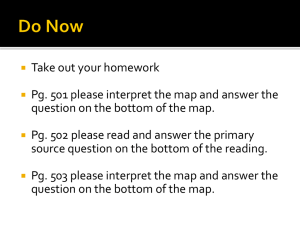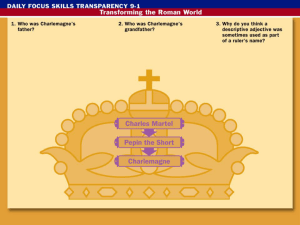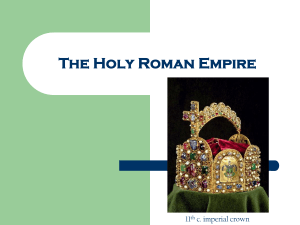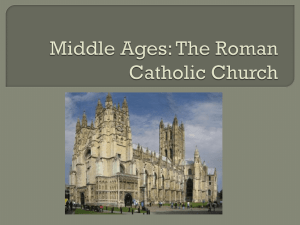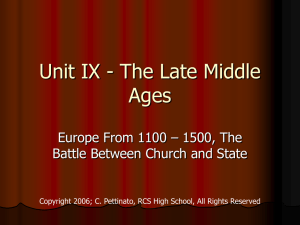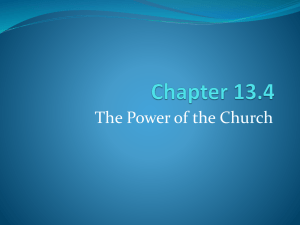WH Ch 8.2 pp notes
advertisement
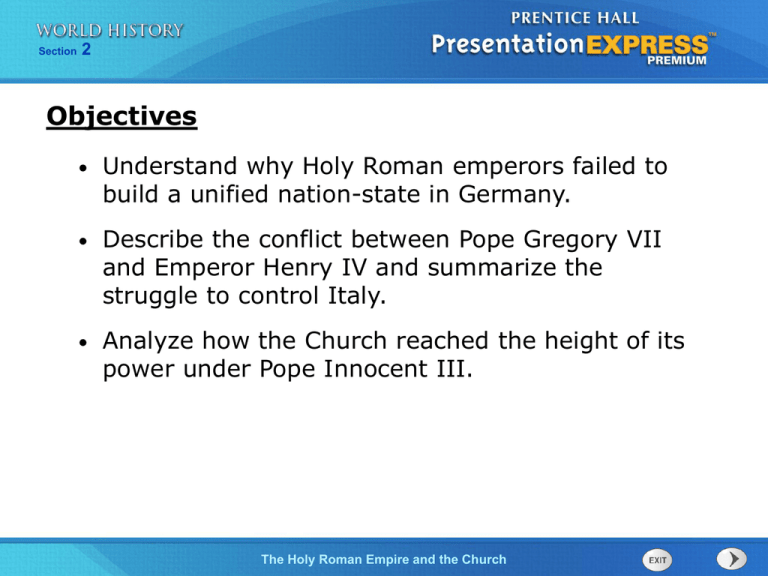
Section 2 Objectives • Understand why Holy Roman emperors failed to build a unified nation-state in Germany. • Describe the conflict between Pope Gregory VII and Emperor Henry IV and summarize the struggle to control Italy. • Analyze how the Church reached the height of its power under Pope Innocent III. The Holy Roman Empire and the Church Section 2 Terms and People • Holy Roman Empire – from 962 to 1806 an empire comprising present-day Germany and neighboring lands • Henry IV – crowned king of Germany in 1054, later became Holy Roman emperor • Pope Gregory VII – the pope who wanted to make the Church independent of secular rulers • lay investiture – the practice in which a bishop is appointed by someone who is not a member of the clergy The Holy Roman Empire and the Church Section 2 Terms and People (continued) • Frederick Barbarossa – the Holy Roman emperor who tied Germany to southern Italy through the marriage of his son • Pope Innocent III – proclaimed pope in 1198; claimed supremacy over all other rulers and strengthened papal power within the Church The Holy Roman Empire and the Church Section 2 How did explosive conflicts between monarchs and popes affect the balance of power in Europe? The Church was very powerful during the Middle Ages. Monarchs were also powerful, and the two factions were often in conflict. The rulers of the Holy Roman Empire in particular struggled with the Church for many years. The Holy Roman Empire and the Church Section 2 When Otto I became king of Germany he worked with the Church. The grateful pope crowned him emperor. His successors used the title Holy Roman emperor. They saw themselves as heirs to the emperors of ancient Rome. The Holy Roman Empire and the Church Section 2 Other emperors would clash with the Church for power and control. Control of the emperor’s vassals was important. The real rulers of the German lands were these nobles and Church officials. The Holy Roman Empire and the Church Section 2 Who would get to appoint bishops? The pope or the emperor? Pope Gregory VII wanted to make the church independent of secular rulers. Emperor Henry IV wanted to appoint the vassals in his lands. This issue erupted into a major power struggle. The Holy Roman Empire and the Church Section 2 It started when Pope Gregory banned lay investiture. This made Henry IV angry, because he saw the position of bishop as a type of royal fief. Next, the pope excommunicated the king. In the end, Henry humbled himself and was restored to the Church. The Holy Roman Empire and the Church Section 2 Henry IV later led an army to Rome and forced the pope into exile. The issue over investiture was finally settled 50 years later with a treaty called the Concordat of Worms. The Holy Roman Empire and the Church Section 2 The investiture struggle was over. As emperors looked to Italy in the 1100s, however, new conflict with popes occurred. The Holy Roman emperor Frederick Barbarossa fought for many years to bring Italy under his control. The Holy Roman Empire and the Church Section 2 The Italy campaign was a failure. Though Frederick did arrange a marriage that tied German emperors to southern Italy, he did not conquer the region. Meanwhile, German nobles became more independent. Ultimately, the Holy Roman Empire remained a patchwork of feudal states. The Holy Roman Empire and the Church Section 2 The Church reached the height of its political power in the 1200s. Pope Innocent III took office in 1198 and claimed supremacy over all other rulers. He placed kingdoms under interdict and launched a brutal crusade in southern France. After his death, the papacy entered a period of decline. The Holy Roman Empire and the Church



